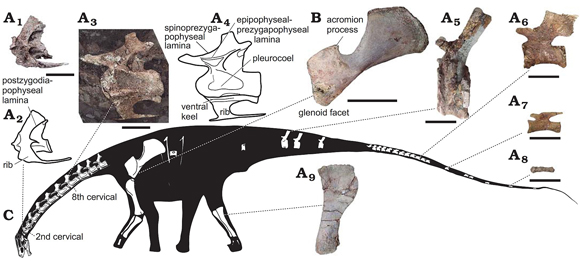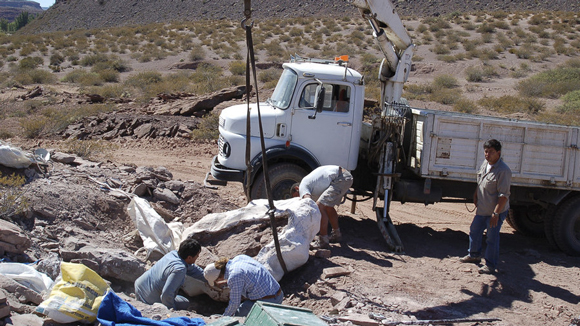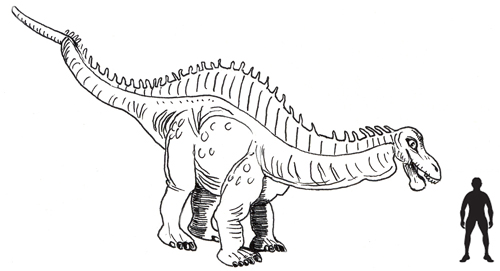Lavocatisaurus agrioensis – A New Long-Necked Dinosaur from Argentina
A team of palaeontologists from Argentina and Spain have announced the discovery of a new species of long-necked dinosaur from the Early Cretaceous of Argentina. The dinosaur, represented by a set of bones that indicate the remains of at least three individuals, has been named Lavocatisaurus agrioensis and it will help to shed more light on a rare and enigmatic group of sauropods known as the rebbachisaurids.
A Skeletal Reconstruction and Photographs of Key Fossils from L. agrioensis

Picture credit: AFP/Agencia CTYS
The picture above shows the skeletal drawing of the adult dinosaur with illustrations of key bones from the excavation. Most of the neck and the skull has been recovered. Cranial fossils associated with the Rebbachisauridae are rare, the discovery of these specimens from Agrio del Medio (Neuquén Province, Argentina) will help scientists to better understand taxonomic relationships amongst members of this sauropod family, largely associated with Gondwanaland fossil deposits.
Fossils of a Family Group?
Writing in the journal “Acta Palaeontologica Polonica”, the scientists report the discovery of one large, presumably adult animal with two smaller sub-adults found in association. The fossil material come from terrestrial sandstone deposits laid down around 110 million years ago (Aptian to Albian faunal stage of the Early Cretaceous), in an arid environment with isolated oasis and other water sources (Rayoso Formation).
One of the authors of the scientific paper, José Luis Carballido, of the Egidio Feruglio Museum (Argentina), stated:
“We found most of the cranial bones: the snout, the jaws, a lot of teeth, also the bones that define the eye sockets for example and in that way, we were able to create an almost complete reconstruction. Not only is this the discovery of a new species in an area where you wouldn’t expect to find fossils, but the skull is almost complete.”
Lavocatisaurus agrioensis
The fossils represent one large dinosaur estimated to be around twelve metres in length and two smaller animals around six to seven metres in length. The research team postulate that this could represent a family group that lived together and perished together, perhaps unable to find a water source in a time of drought.
Preparing to Move Some of the Fossil Material (Lavocatisaurus)

Picture credit: AFP/Agencia CTYS
Lead author of the paper, José Ignacio Canudo (Zaragoza University, Spain) added:
“This discovery of an adult and two juveniles also signifies the first record of a group displacement among the Rebbachisaurus dinosaurs.”
The Rebbachisauridae Family
The Rebbachisauridae family of sauropods are a group of basal members of the Diplodocimorpha clade that includes more famous Late Jurassic dinosaurs such as Diplodocus, Apatosaurus and Brontosaurus. The rebbachisaurids are known from both Lower Cretaceous and Upper Cretaceous strata and had a wide geographical distribution throughout Gondwana and southern Laurasia with fossils reported from north and central Africa as well as South America and Europe (Spain).
An Illustration of a Typical Rebbachisaurid Dinosaur (R. garasbae)
Picture credit: Everything Dinosaur
Visit the Everything Dinosaur website: Everything Dinosaur.







Hola, muy buena info ¿me gustaría saber cual son los parientes más cercanos del lavocatisaurus?
Lavocatisaurus is a member of the Rebbachisauridae family of Sauropods in the scientific paper it was proposed that Lavocatisaurus was closely related to Comahuesaurus and a sister taxon to Limaysaurus and Cathartesaura.
Lavocatisaurus es miembro de la familia de Sauropods Rebbachisauridae. En el artículo científico se propuso que Lavocatisaurus estaba estrechamente relacionado con Comahuesaurus y una taxona hermana de Limaysaurus y Cathartesaura.